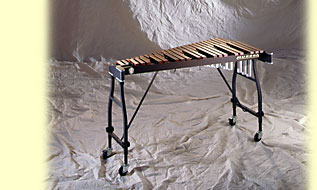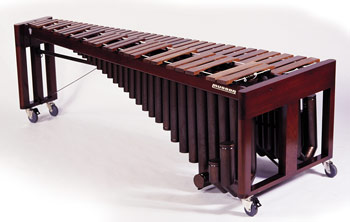|
Reference and Fun Stuff
Composers A-Z |
|
Miscellaneous |


Da Pit
This page is, obviously, under construction, and is not up yet. If you hadn't figured it out yet, I am a band geek all the way, and the Pit is definitely the most awesome section!!! More specifically, MALLET INSTRUMENTS RULE!!! This year, we even got some fun and kind of challenging parts! If you need an idea of what we are playing, check out, on the sound files page, the song Borderline, which we are playing as part of our field show. I will add to this page soon, so please return. Thanks!!!

So what's so different about these instruments, anyways?

The XYLOPHONE is most often used in the symphony orchestra and concert band. The bar material is usually wood, preferably Honduras rosewood. The instrument is played with hard rubber or plastic mallets, and has a brilliant, incisive tone. The resonators (if used) are relatively short in length, extending only about halfway down the frame. The instrument sounds one octave higher than written, so the top note on a standard instrument sounds the same as the highest note on the piano.

The MARIMBA is most often used as a solo instrument or in small ensembles. The bars are made of the same wood used in the xylophone, but they are cut differently, giving a mellow, warm tone that can be almost organ-like in the low register. Mallets are usually covered with yarn or cord. Resonators extend to the bottom of the frame at the lowest point. The instrument sounds where written. This is the instrument I prefer over any other.

The VIBRAPHONE is most often used in jazz. The bars are made of a metal alloy, usually aluminum. The bars are cut like the mellower marimba rather than the more brilliant xylophone. Mallets are covered in cord or yarn, and are often mushroom-shaped. Resonators extend near the base of the frame at their lowest point, and like the marimba the instrument sounds where written. The vibraphone has two additional distinguishing characteristics: the pedal and the motor. The pedal mechanism works exactly like the sustain (right) pedal on the piano. The motor operates a series of fans (one for every note) that open and close the resonators at various speeds that can be controlled by the performer. These fans add a vibrato to the tone.
I got a lot of pictures for this site off the Musser web site, and so if you would like to go to the site, click here.